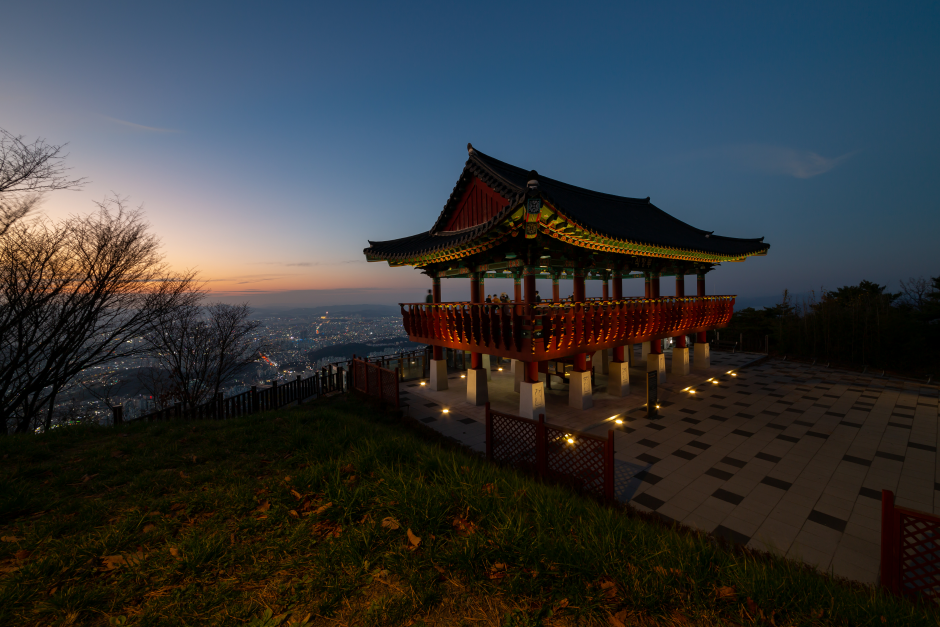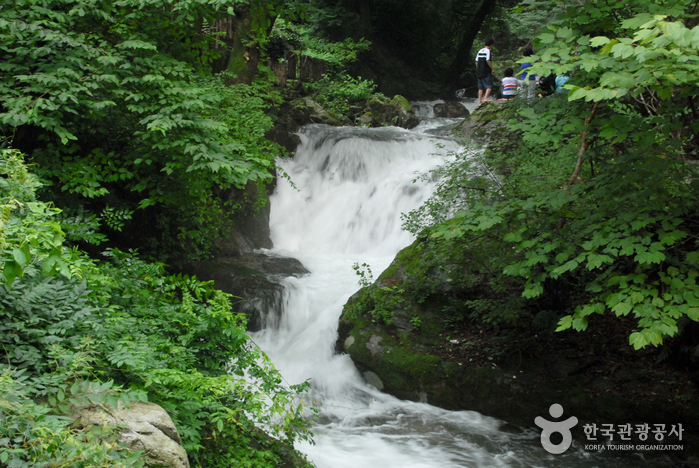Geumnam Egret Habitat (금남 백로 서식지)
11.0 Km 11857 2022-08-25
45-13, Gamseong-gil, Geumnam-myeon, Sejong-si
+82-44-300-5833
The Egret Habitat in Gamgseong-ri covers a small mountain located in Yuseong-gu District. Existing since the Joseon dynasty era, the habitat is home to common herons and cattle egrets. Up to 5,000 birds have been observed at one time. The best time to visit the habitat and see the egrets is between April and May.
Byeolcheonji Sikdang (별천지식당)
11.7 Km 29268 2024-02-15
29 Sanseo-ro 1659beon-gil, Dong-gu, Daejeon
Byeolcheonji Sikdang is a Korean nutritious food restaurant renowned for its specialization in baeksuk (whole chicken soup). Their standout dish is oribaeksuk (whole duck soup), meticulously prepared with cordyceps and a blend of traditional medicinal herbs to enrich both its flavor and health benefits. Additionally, the restaurant is acclaimed for its baeksuk made with native chicken and galbi tang (galbi soup). Set next to a serene pond, Byeolcheonji Sikdang provides a peaceful atmosphere for guests to enjoy their meals.
Daecheongho Lake (대청호)
11.7 Km 23097 2022-12-26
Dong-gu, Daejeon / Munui-myeon, Chungcheongbuk-do
+82-42-251-4748
Daecheongho Lake is a man-made lake, stretching from Daejeon to Cheongju-si, Okcheon-gun, and Boeun-gun. Construction began in 1975 and finished in 1980, and the lake supplies water for various use to people in Daejeon and Cheongju.
The reservoir water spans an area of over 72.8 ㎢ with a perimeter of 80 kilometers, and the water kept in storage has a volume of 1.5 billion tons, making the reservoir the third largest lake in Korea. The area is famous for its beautiful driving course along a tree-lined road through the nearby mountain which has an altitude of 200 to 300 meters. Also, resident birds and migratory birds, such as white heron, can be seen during summer in the upper region of the lake.
Sikjangsan Cultural Park (Sunrise Observatory) (식장산 문화공원(해돋이전망대))
11.9 Km 35273 2023-02-09
32-834, Secheongongwon-ro, Dong-gu, Daejeon
Sikjangsan (623.6 meters) is a mountain spanning three regions - Dong-gu of Daejeon, Gunbuk-myeon and Gunseo-myeon of Okcheon-gun. As the tallest peak in the city located in the southeastern part of Dong-gu, Daejeon, it stands proudly next to great mountains in neighboring regions such as Seodaesan, the tallest peak in Chungcheongnam-do (904 meters), and Daeseongsan, the tallest in Okcheon (705 meters). Home of a 4.82 million-square-meter large, natural ecosystem preservation forest designated by the city, Sikjangsan is an ecological repository featuring plants of 224 species, 45 varieties, 187 genera, and 78 families; 45 kinds of mammals such as roe deer, squirrels, wildcats, raccoons and bats; over 100 types of birds; reptiles; and amphibians.
Sikjangsan Cultural Park is an ecological park that continues from Secheon Park to Sikjangsan Sunrise Observatory. The cultural park was established at the peak of the mountain, which had been regarded as one of the best nightscape viewpoints in Daejeon. A traditional tower built inside the cultural park adds a sense of classical dignity. An observatory from which the entire city can be seen in a single view is also located here. People of all ages and genders visit the tower and observatory to enjoy the expansive view of Daejeon.
Red Leaf Willow Habitat (왕버드나무군락지)
12.8 Km 0 2024-02-15
Miho-dong, Daedeok-gu, Daejeon
Red Leaf Willow Habitat is located near Daechung Dam and Geumgang Lohas Daecheong Park, along the Geumgang River. This area is ideal for photography, offering stunning views during sunrise and sunset, with sunlight and mist creating a picturesque scene. The decaying wood of the trees in the wetland area can even emit light on its own during the nighttime.
Sabiseong (Donghak Sanjang Hotel Korean restaurant) (사비성 (동학산장호텔 한식당))
12.9 Km 20280 2024-02-21
266-4 Donghaksa 1-ro, Banpo-myeon, Gongju-si, Chungcheongnam-do
042-825-4301
Sabiseong is a Korean restaurant operated by Donghak Sanjang Hotel, located on the eastern slope of Gyeryongsan Mountain. It offers a variety of traditional Korean dishes such as sagor ugeojiguk (kimchi cabbage soup), hwangtae kongnamulguk (dried pollack and bean sprout soup), yukgaejang (spicy beef soup), sanchae bibimbap (wild vegetable bibimbap), and grilled dishes like samgyeopsal (pork belly) and ori hunje (smoked duck). Nearby attractions include Gyeryongsan National Park, Donghaksa Temple, and the Korean Natural History Museum.
Gujeolsa Temple (구절사)
13.1 Km 19158 2024-02-26
226, Sangjung-gil, Gunseo-myeon, Okcheon-gun, Chungcheongbuk-do
Gujeolsa Temple is a Buddhist temple located deep within the Sikjangsan Mountain in Okcheon. It was founded in 1393 and was rebuilt in 1933 to its present appearance. The road from the radio tower fork to Gujeolsa Temple in Sikjangsan Mountain’s hiking trails is lush with acacia trees, which are in full bloom in May. Another sight that should not be missed is the fog shrouding the foot of the mountain in spring and fall.
Gyeryongsan National Park (계룡산국립공원)
13.5 Km 48858 2021-09-06
327-6, Donghaksa 1-ro, Gongju-si, Chungcheongnam-do
+82-42-825-3002
Gyeryongsan National Park stretches across the cities of Daejeon, Gongju, and Nonsan in Chungcheongnam-do and was made a national park on December 31, 1968. The name of the mountain comes from the fact that the ridgeline looks like a dragon wearing a chicken's crest on its head. The topographical features are what make this mountain stand out and its mysterious folklore is what makes it so interesting. The park features many peaks, including the main peak Cheonhwangbong (alt. 845.1 m), as well as Sambulbong, Yeoncheonbong, and Gwaneumbong Peaks. This mountain is famous for its many interesting sites, with its fantastic rock structures and Yongmunpokpo Falls on the west, Eunseonpokpo Falls to the east, and Amyongchu and Sutyongchupokpo Falls in the south.
In spring, cherry blossoms bloom along the path to Donghaksa Temple, and during summer the lush green of the valley is very beautiful. During fall, the maple trees reveal their crimson colored leaves around Gapsa Temple and Yongmunpokpo Falls. The snowcapped peak of Sambulbong in winter is simply breathtaking. Gyeryongsan is full of rare animals and plants, beautiful waterfalls and a rich history with mysterious legends and cultural treasures. To the east is Donghaksa Temple; northwest, Gapsa Temple; southwest, Sinwonsa Temple; and southeast, Yonghwasa Temple.
Cheongnamdae Presidential Villa (청남대)
13.6 Km 33836 2023-04-13
646, Cheongnamdae-gil, Sangdang-gu, Cheongju-si, Chungcheongbuk-do
+82-43-257-5080
Cheongnamdae, which means "Cheong Wa Dae in a warm southern land," was once a private villa used by former presidents of Korea. Cheongnamdae became open to the public on April 18, 2003. It is located near Daecheong Dam in Cheongwon-gu, Chungcheongbuk-do and was built in 1983. The total area spans 1,825,000m² and consists of a main building, golf range, heliport, and fishing area. The natural environment surrounding the area has been well preserved, serving as a home to wildlife, including over 143 species of wild flowers and 124 species of trees as well as several endangered species.



 English
English
 한국어
한국어 日本語
日本語 中文(简体)
中文(简体) Deutsch
Deutsch Français
Français Español
Español Русский
Русский